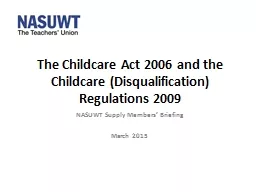PPT-NASUWT Doncaster
Author : mitsue-stanley | Published Date : 2016-06-11
Classroom Management Anyone who has never made a mistake has never tried anything new Albert Einstein Aims amp Objectives Theme To identify practical approaches
Presentation Embed Code
Download Presentation
Download Presentation The PPT/PDF document "NASUWT Doncaster" is the property of its rightful owner. Permission is granted to download and print the materials on this website for personal, non-commercial use only, and to display it on your personal computer provided you do not modify the materials and that you retain all copyright notices contained in the materials. By downloading content from our website, you accept the terms of this agreement.
NASUWT Doncaster: Transcript
Download Rules Of Document
"NASUWT Doncaster"The content belongs to its owner. You may download and print it for personal use, without modification, and keep all copyright notices. By downloading, you agree to these terms.
Related Documents














